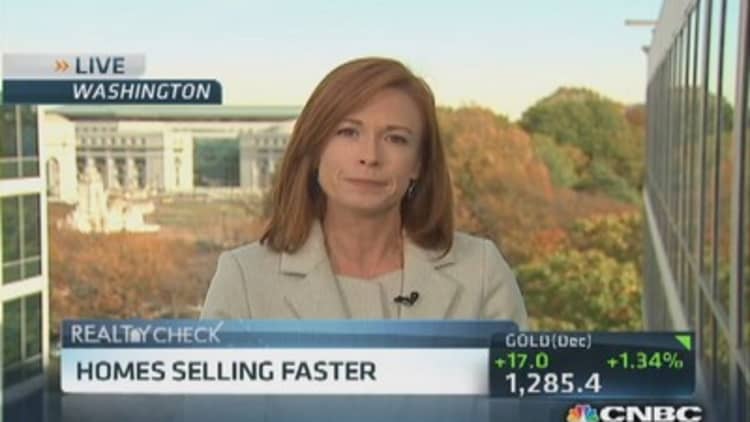Home sales and home remodeling usually rise and fall in tandem, but remodeling may now be recovering faster. Remodeling first began to surge in 2009, well before home prices and sales began their recovery. Investors purchased millions of distressed homes, many of which had been gutted or even vandalized by disgruntled former owners.
In order to rent the homes, they had to remodel them, whether it was paint and polish or more extensive work. Now, as home sales bounce back, and, perhaps more importantly, as thousands of homeowners regain much-needed equity in their homes, remodeling is seeing greater gains.
"In the near term, homeowner spending on improvements is expected to see its strongest growth since the height of the housing boom," said Kermit Baker, director of the Remodeling Futures Program at the Harvard Joint Center for Housing Studies.
Home remodeling projects jumped 14 percent in September from a year ago, according to a new report from BuildFax, a data company that tracks building permits. The trends, however, are changing. Smaller remodeling projects, those under $10,000, are dropping, while more expensive projects are rising. This is likely because more regular homeowners are starting to renovate, as investors in cheaper rentals are a diminishing share of that market.
Consumer confidence in housing is also returning, so people are spending again. Witness better-than-expected quarterly earnings at the No. 1 home improvement retailer, Home Depot. The company also raised its fiscal-year outlook for the third time this year. This shift to more expensive and expansive renovations is now providing unique opportunities for new companies to profit, especially as consumers move out of showrooms and get online to plan projects.
"The strength of your presence on the Web is numero uno. Everything else is secondary," said Gary Case of Rockville, Md.-based Signature Kitchens.
Local design-build and product websites are gaining even more traction from the growth of sites that aggregate ideas and trends in remodeling, like Houzz, Pinterest and DIY Network. A newcomer to the mix now gets local, allowing consumers to find not only contractors and specialty tradesmen in their neighborhoods but to literally look inside their neighbors' renovations.
"Porch is the first and really the only home improvement network," said Matt Ehrlichman, CEO of Porch.com. "We've spent a long time aggregating a tremendous amount of information about projects that have happened in homes, and the professionals that have done them, to help homeowners with problems that they have never been able to do easily before."
(Read more: And America's top housing market is...)

A consumer going on Porch enters his or her's ZIP code and immediately gets a map of the area, dotted with the names of contractors, tradesmen, architects and design-build firms working in their neighborhood. In addition to the professionals, there are also little cameras, which when clicked show pictures of neighbors' renovations. Names and addresses are not included, but people can get a general idea of where they are.
"The only things that have really existed in the past are review sites. Some are paid, some are free, where consumers go in and they read third-party reviews. Sometimes they are real, sometimes they are not," said Ehrlichman.
Architect Bruce Wentworth is now pouring most of his marketing resources into social media. Listed on Porch and Houzz, the founder of Washington, D.C.-based Wentworth, a design-build firm, said social media validates his expertise and reputation.
(Read more: House shopping? Get prepared)
"In the long term it's excellent because people will really begin to see who are the better firms, who does the better design, who does the best construction, who is more trustworthy and reliable and has proper credentials," said Wentworth.
Karen Smith gutted her 1930s home to add space and modernize. She found her architect the old-fashioned way, by word of mouth from a trusted realtor, but social media sites came into play toward the end of the project.
"We started three to four years ago, a little before all of that stuff got really big. In the final stages, my husband discovered Houzz, and we certainly have looked on there a lot for more decorating ideas," said Smith.
Had she started the project today, Smith noted she would have used design websites more.
(Read more: Map: Tracking the recovery)
"I definitely think it would be a complementary tool to word of mouth, and all those other ways you find people to do things for you," Smith added.
Confidence is key for homeowners, who readily admit that renovations are as emotional as they are costly. Porch's Ehrlichman said his site gives consumers confidence that the professionals they choose are trusted and competent. Wentworth said the sites help consumers avoid over-improving their homes, given the price point in their local neighborhood. Of course there are downsides.
"It's easier for your competition to find out what you're doing, and if there's a problem client, it can be a negative if it's not handled properly," added Wentworth.
—By CNBC's Diana Olick. Follow her on Twitter @Diana_Olick. CNBC Real Estate Producer Stephanie Dhue contributed to this report
Questions? Comments? facebook.com/DianaOlickCNBC


